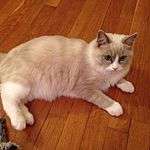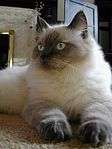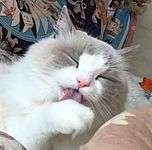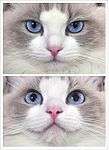Ragdoll
| Ragdoll | |
|---|---|
 | |
| Origin | United States |
| Breed standards | |
| CFA | standard |
| FIFe | standard |
| TICA | standard |
| AACE | standard |
| ACF | standard |
| ACFA/CAA | standard |
| CCA-AFC | standard |
| Domestic cat (Felis catus) | |
The Ragdoll is a cat breed with blue eyes and a distinct colorpoint coat. It is a large and muscular semi-longhair cat with a soft and silky coat. Developed by American breeder Ann Baker in the 1960's,[1] it is best known for its docile and placid temperament and affectionate nature. The name "Ragdoll" is derived from the tendency of individuals from the original breeding stock to go limp and relaxed when picked up.[2] Particularly popular in both the United Kingdom and the breed's native United States, ragdoll cats often are known as "dog-like cats" or "puppy-like cats" due to behaviors such as their tendency to follow people around, their ease at being physically handled, and their relative lack of aggression toward other pets.[3]
History
In the 1960s, a regular non-pedigreed white domestic longhaired cat named Josephine produced several litters of typical cats. Josephine was of a Persian/Angora type and had litters sired by several unknown male Birman or Burmese-like cats, one of which had the Siamese point coloration. Josephine later produced kittens with a docile, placid temperament, affectionate nature, and a tendency to go limp and relaxed when picked up. When a subsequent litter produced more of the same, Ann Baker purchased several kittens from the owner who lived behind her and, believing that she had something special, set out to create what is now known as the ragdoll. The breed was selectively bred over many years for desirable traits, such as large size, gentle demeanor, and a tendency to go limp when picked up, as well as the striking pointed coloration.[4]
Out of those early litters came Blackie, an all black Burmese-like male, and Daddy Warbucks, a seal point with white feet. Daddy Warbucks sired the founding bi-color female Fugianna, and Blackie sired Buckwheat, a dark brown/black Burmese-like female. Both Fugianna and Buckwheat were daughters of Josephine. All Ragdolls are descended from Baker's cats through matings of Daddy Warbucks to Fugianna and Buckwheat.[5]
Baker, in an unusual move, spurned traditional cat-breeding associations. She trademarked the name "Ragdoll", set up her own registry (the International Ragdoll Cat Association (IRCA)) ca. 1971, and enforced stringent standards on anyone who wanted to breed or sell cats under that name.[4] The Ragdolls were also not allowed to be registered in other breed associations.[6][7] The IRCA is still in existence today but is quite small, particularly since Baker's death in 1997. IRCA cats are not recognized in any major cat breed organization or cat show.
In 1975, a group led by a husband-and-wife team, Denny and Laura Dayton, broke ranks with the IRCA with the aim of gaining mainstream recognition for the Ragdoll. Beginning with a breeding pair of IRCA cats, this group eventually developed the Ragdoll standard currently accepted by major cat registries such as the CFA and the FIFe.[8]
Since the spread of the Ragdoll breed in America during the early 1960s, a breeding pair of Ragdolls was exported to the UK. This was followed by eight more cats to fully establish the breed in the UK, where it is recognised by the Governing Council of the Cat Fancy[9]
In 1994, a second group decided to leave the IRCA and form its own group owing to increasingly strict breeding restrictions. This group later established the Ragamuffin breed. Because Baker owned the rights to the name "Ragdoll", no offshoot groups were legally able to call their cats Ragdolls until 2005, when the trademark on "Ragdoll" was not renewed.[10]
The largest international Ragdoll breed club is the Ragdoll Fanciers' Club International (RFCI).[11]
Breed description
Temperament

The Ragdoll is marketed by breeders as having a docile, calm and floppy nature with claims that these characteristics have been passed down from the Persian and Birman breeds. Opinions vary as to whether this trait might be the result of genetic mutation.[12][13] The extreme docility of some individuals has led to the myth that Ragdolls are pain resistant. Some breeders in Britain have tried to breed away from the limpness owing to concerns that extreme docility "might not be in the best interests of the cat".[12][14]
Breed standard marketing and publicity material describe the Ragdoll as affectionate, intelligent, relaxed in temperament, gentle, and an easy-to-handle lap cat.[15][16] The animals are often known as "puppy cats", "dog-like cats", "cat-dogs", etc., because of their placid nature and affectionate behavior, with the cats often following owners from room to room as well as seeking physical affection akin to certain dog breeds. Ragdolls can be trained to retrieve toys and enjoy doing so.[3]
Physical characteristics
The Ragdoll is one of the largest domesticated cat breeds, with a sturdy body, large frame, and proportionate legs. A fully-grown female weighs from 8 to 15 pounds (3.6 to 6.8 kg). Males are substantially larger, ranging from 12 to 20 pounds (5.4 to 9.1 kg) or more.[4] The genes for point coloration are also responsible for the blue eyes of the Ragdoll. More intense shades of blue are favored in cat shows. Although the breed has a plush coat, it consists mainly of long guard hairs, while the lack of a dense undercoat results, according to the Cat Fanciers' Association, in "reduced shedding and matting".[17] Mitted Ragdolls, which weren't allowed titling in CFA until the 2008-2009 show season, are often confused with Birmans. The easiest way to tell the difference is by size (the Ragdoll being obviously larger) and chin color (Mitted Ragdolls have white chins,[18] while Birmans have colored chins), although breeders recognize the two by head shape and boning.
Ragdolls come in 6 different colors: red, seal, chocolate and the corresponding "dilutes", including blue, lilac, and cream. This also includes the tortoiseshell pattern in all colors and the three patterns. "Traditional" Ragdoll kittens are born white; they have good color at 8–10 weeks and full color and coat at 3–4 years. The four different patterns are:
- Pointed – One color darkening at the extremities (nose, ears, tail, and paws).
- Mitted – Same as pointed, but with white paws and abdomen. With or without a blaze (a white line or spot on the face), but must have a "belly stripe" (white stripe that runs from the chin to the genitals) and a white chin.
- High Mitted Bicolor–Same as mitted, with white paws, chest and abdomen. White V mark on the face. The color can be blue, seal, red, chocolate, and cream.
- Bicolor – White legs, white inverted V on the face, white abdomen and sometimes white patches on the back. (Excessive amounts of white, or "high white", on a bicolor is known as the Van pattern, although this doesn't occur nearly as often as the other patterns.)
- Lynx – A variant of the above type having tabby markings.[19]
Gallery
-

A female blue high mitted ragdoll
-

A blue pointed ragdoll with darkened extremities.
-

The mitted pattern is similar to the pointed with the exception of the white paws, chin and abdomen.
-

Blue-eyed kitten. The white patch in the shape of an inverted 'V' on the face indicates a "bicolor" pattern.
-

Blue bicolor ragdoll cleaning her paw.
-
A seal lynx pointed Ragdoll, about three years old.
-

A female blue bicolor ragdoll with a white mark.
Health
One study utilizing Swedish insurance data showed that of the common cat breeds, the Ragdoll and Siamese have the lowest survival rate. They live 15 to 25 years.[20] This study indicates the Ragdoll may have a significantly higher number of cats that die of urinary problems, mainly from kidney/ureter issues, but also partly from lower urinary issues. Whether this is an issue outside of Finland, Sweden, or Denmark is unclear.
Inbreeding
Background inbreeding is severe, around 40%, owing to the very limited number of foundation cats. Around 45% of the genes come from only one founder, Ann Baker.[21]
Hypertrophic cardiomyopathy
Hypertrophic cardiomyopathy (HCM) is a common heart disease in all cats and is most commonly genetic in cause. The disease causes thickening of the heart wall, which makes the heart pump less efficiently. It can, in some instances, lead to sudden death. In Ragdolls homozygous positive for the disease (having two copies of the HCM gene), the condition can present early (as young as six months) and tends to be severe, with most cats dying by age 3. Heterozygous (one copy of HCM gene) cats tend to have later onset and slower progression of the disease with less severe impact. A DNA test was developed in 2007 to identify the gene that causes HCM in Ragdolls. Breeding only from Ragdolls that are free from this gene (homozygous negative) will ensure that they will not develop the form of HCM associated with it.[22][23] The allelic frequencies of the Ragdoll HCM mutation R820W were 0.17 in cats from Italy and 0.23 in cats from the USA in 2013.[24] This reference states that the R820W prevalence is 30% in UK.[25] The HCM prevalence was found to be 2.9% (95% CI 2.7 -8.6% ) in this study.[24]
References
- ↑ "The Ragdoll Cat". Cats Breed. 2013-09-06. Retrieved 2014-08-15.
- ↑ Why Do Cats Always Land on Their Feet?: 101 of the Most Perplexing Questions ... - Marty Becker, Gina Spadafori - Google Books. Books.google.com. 2006-09-16. Retrieved 2014-08-15.
- 1 2 Benjamin L. Hart; Lynette A. Hart (2013). Your Ideal Cat: Insights Into Breed and Gender Differences in Cat Behavior. Purdue University Press. pp. 99–101.
- 1 2 3 Helgren, J. Anne (2006). "Ragdoll". Iams. Telemark Productions.
- ↑ "Ragdoll History-The Beginning". Ragdoll Historical Society. Retrieved 2014-10-06.
- ↑ "Ragdoll". Iams. Archived from the original on 2007-09-28.
- ↑ Robbins, Nancy (2012-02-14). Domestic Cats: Their History, Breeds and Other Facts. CreateSpace. p. 220. ISBN 9781470075385.
- ↑ "raistrickragdolls". Retrieved 15 November 2014.
- ↑ "Welcome to the Governing Council of the Cat Fancy". Retrieved 2010-12-14.
- ↑ U.S. trademark number 1,026,916.
- ↑ "Ragdoll Fanciers Club International- Ragdoll Cat Breeders Club - Welcome". Rfci.org. Retrieved 2014-08-15.
- 1 2 Understanding Cat Behavior: The Complete Feline Problem Solver Roger Tabor (2003). P 33.
- ↑ Do cats always land on their feet Gina Spadafori, Marty Becker
- ↑ The Cat: Its Behavior, Nutrition & Health Linda P. Case, Kerry Helms, Bruce Macallister (2003). P 31.
- ↑ Ragdoll Breed standard Governing Council of Cat Fancy
- ↑ Ragdoll Breed standard Cat Fanciers' Association
- ↑ Breed Profile Cat Fanciers' Association
- ↑ Mattern, Joanne. The Ragdoll Cat. capstone press. p. 19.
- ↑ "Ragdoll International Patterns and Colors". Retrieved 2012-06-11.
- ↑ Egenvall, A.; Nødtvedt, A.; Häggström, J.; Ström Holst, B.; Möller, L.; Bonnett, B. N. (2009). "Mortality of Life-Insured Swedish Cats during 1999—2006: Age, Breed, Sex, and Diagnosis". Journal of Veterinary Internal Medicine. 23 (6): 1175–1183. doi:10.1111/j.1939-1676.2009.0396.x. PMID 19780926.
- ↑ "The Ragdoll Database".
- ↑ "Minutes of Executive Council Meeting No: 28 (doc)". New Zealand Cat Fancy. 24–25 September 2011. Retrieved 2012-02-08.
- ↑ "Frequently Asked Questions about the HCM Genetic Mutation Predominantly Found in Ragdoll Cats". NC State College of Veterinary Medicine. Retrieved 2012-02-08.
- 1 2 "Myosin-Binding Protein C DNA Variants in Domestic Cats (A31P, A74T, R820W) and their Association with Hypertrophic Cardiomyopathy" (PDF).
- ↑ "Hypertrophic cardiomyopathy (HCM) in cats".